Flesh and Blood is a game that accommodates a variety of formats, and with that comes opportunities to tailor your experience to what suits you and your play group best. The more that it grows, the more unique and interesting variations are spawned. From Chaff Goblin to Draft, Classic Constructed to UPF, there are just so many ways that you can engage with its deep library and have a great time. At my local game store, we like to host a Jank Week after major competitions come to a close. That's the inspiration for today's feature.
As a Guardian main, I've seen this list come and go for the last few years, and now I want to share with you my own iteration on the idea. May I present to you: Mobile Yoji.
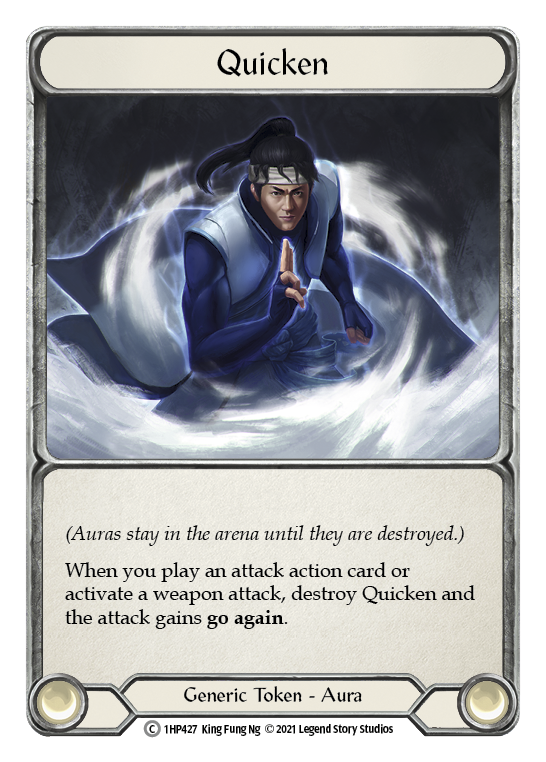
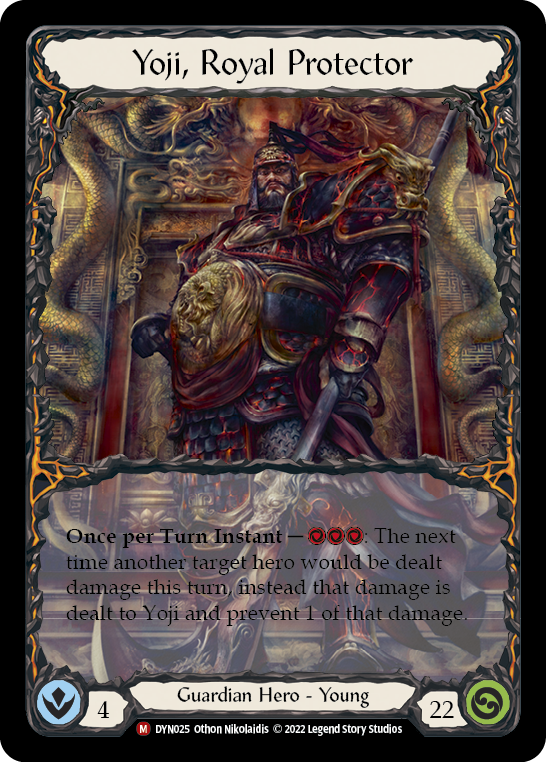
Get to Know Yoji
Yoji is a largely overlooked character due to his ability's irrelevance outside of Ultimate Pit Fight. At present, there's no official format for 'teaming up' with another player, so Yoji has little incentive to reassign damage to himself. That leaves Yoji's 22 health as the sole reason you might consider him.
Some have taken this as motivation to build Yoji for survival, packing the deck with life gain to ensure we're left standing when the Blitz has died down. But being the Royal Guardian means training in lots of different disciplines, and not always sticking to the same routine. The LSS hero page gives us some insight into his motivations and how he's designed to be played, but we are going to explore a different part of the card pool today. Today, Yoji is getting in his cardio and taking people by surprise with grace.
This deck technically works in any guardian, but I think Yoji's extra little oomph of health makes enough of a case for him to be chosen at this stage of the game.
The Decklist

Weapons
- Sledge of Anvilheim (1)
Equipment
- Helm of Isen's Peak (1)
- Nullrune Gloves (1)
- Fyendal's Spring Tunic (1)
- Snapdragon Scalers (1)
- Nullrune Hood (1)
- Nullrune Boots (1)
- Crater Fist (1)
- Tectonic Plating (1)
Loadout
- Brandish (Red) (2)
- Chokeslam (Blue) (2)
- Coax a Commotion (Red) (2)
- Energy Potion (Blue) (2)
- Flock of the Feather Walkers (Blue) (2)
- Debilitate (Blue) (2)
- Even Bigger Than That! (Blue) (2)
- Even Bigger Than That! (Yellow) (2)
- Macho Grande (Blue) (2)
- Brandish (Blue) (2)
- Cranial Crush (Blue) (2)
- Flock of the Feather Walkers (Yellow) (2)
- Even Bigger Than That! (Red) (2)
- Thunder Quake (Blue) (2)
- Flock of the Feather Walkers (Red) (2)
- Timesnap Potion (Blue) (2)
- Unmovable (Blue) (2)
- Sigil of Solace (Red) (2)
- This Round's on Me (Blue) (2)
- Zealous Belting (Red) (2)
First and foremost, we should reiterate: we are playing Yoji solely for that extra 1hp he gives you over Valda (well, and because he's a studly mountain of a man). His textbox is pretty much not to be used. Now, I haven't quite run the numbers, but I can tell you from my gut that having that extra little bit of health right from the start gives us an edge - and we need all the edges we can take, because this deck is a blunt instrument. The only on-hit effects that we run: Coax a Commotion and Even Bigger Than That; outside of those, this is a numbers game.
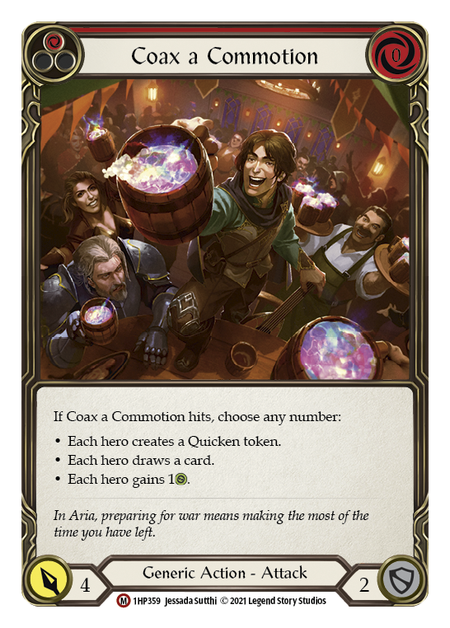
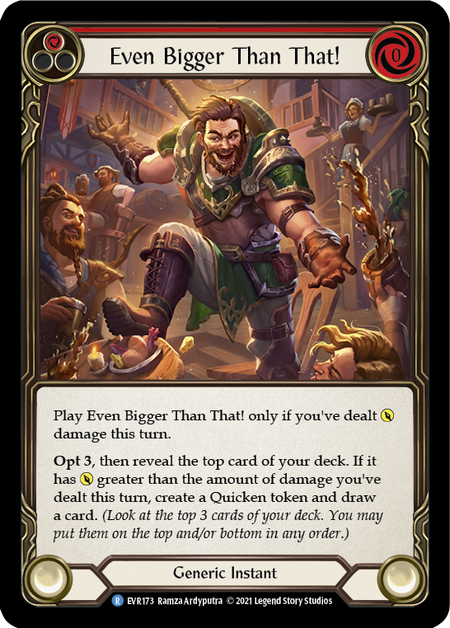

This deck is built around one simple fact: Sledge of Anvilheim does not say “once per turn” on its attack ability. With enough action points and enough resources, we are on our way to the moon with our whirlwind-hammer strikes! That makes the above cards a perfect fit as sources of Quicken tokens. Likewise, we are running Flock of the Feather Walkers and Timesnap Potions, with Snapdragon Scalers to kick everything off. (Snapdragon Scalers are almost exclusively for use with a Flock of the Feather Walkers, so as to pull off a huge turn.)
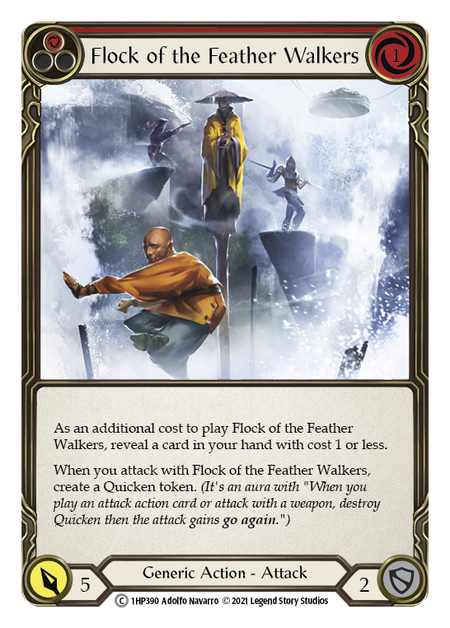
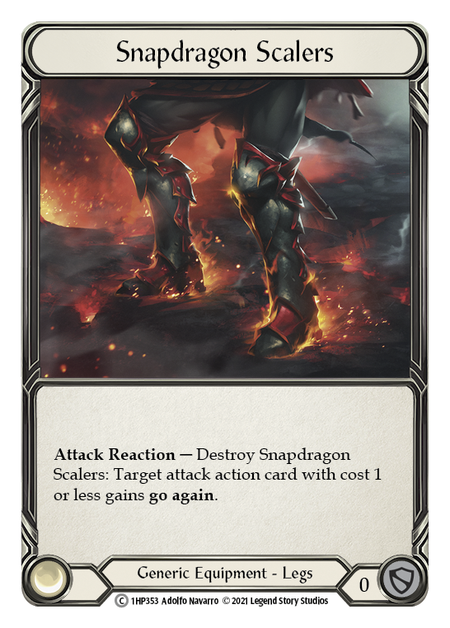
The deck is built around a few different play patterns. We want to have turns where we make Quicken tokens or stick potions in play, interspersed with turns where we use Quicken tokens and Quicken-token-generators to attack 2, 3, or even 4 times in a turn. So, “off” turns, and “on” turns. For one of the off turns, we have to make use of Helm of Isen's Peak to ensure a 6-card setup and close the game with as many generic attacks and hammer swings as possible!
Swinging this hammer is absolutely a task unto itself, as it costs 4. Therefore, it's natural to run Fyendal’s Spring Tunic, making any single-blue-card hand worth 6 damage - but I sometimes run Tectonic Plating for the extra block, to be honest. The core of the deck does benefit from Tunic to pull off those ‘3-card-block, hold a blue up’ turns every so often, and that is nothing to readily discard; but having the 3 extra life points from Tectonic Plating can sometimes be more valuable.
We run all the reasonable options that we can, when it comes to go-again, but at the end of the day you only have so many ways to give the hammer go again. We have to be conservative about how we utilize those options.
Two Energy Potions lets you swing the hammer when you've just blocked with every card in your hand. After those are out, we have to pair 3-card hands with Timesnap Potions or Quicken tokens. Having two 12-damage 2-card turns is usually better than having one 0-card 6 turn, but your mileage may vary and that play may well be all you need to pivot back and strip three cards back from them if they are at 1hp and have a few 2-blocks left.


A Timesnap and an E-Pot lets you pop off with 12 damage if you have 2 blues in hand, and you can do this twice – I generally think that this is the optimal setup that we want to arrive at in the endgame, as it allows us to block with 2 cards and present 12 back, twice. It is therefore also important to be sure to stick your potions in play when you can, because they can be really important in the late game.
This deck, like so many other Guardian decks, comes with a lot of blues in tow. With at least 1 blue in a 2-card hand, we can swing the hammer; with three blues and a little finesse, we are sending the hammer twice - which is usually enough to put somebody on the back foot and stick in serious damage.
A majority of the blues are included just to have easy targets for Even Bigger Than That to see. Frankly, sometimes sending Macho Grande is the way you end the game, although I prefer to pitch it, trying to attack for 18 instead. Blue Debilitate may be well replaced by blue Staunch Response, and Red Brandish might do better as Sink Below, depending on the speed of the casual meta you are playing this deck in. But I like trying to go for things like Brandish just to force blocks and widen my own turns - it feels good to juke an opponent with Brandish, like maybe hammering for 7 if they let it hit or playing out the blue potion i’m holding if they block it.
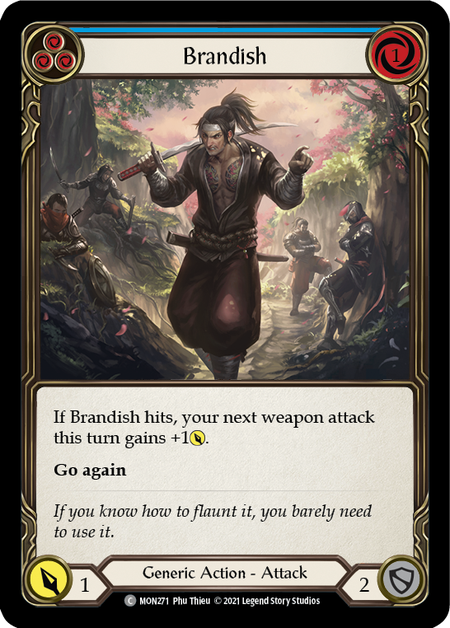

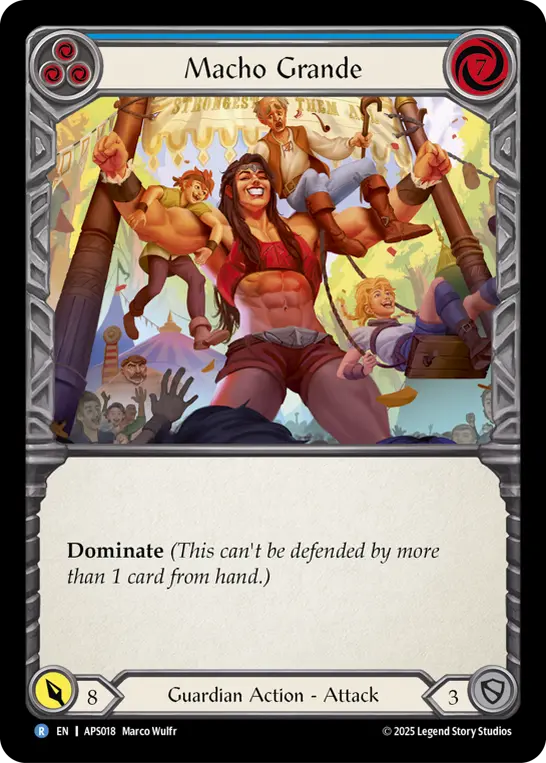
Brandish, in particular, can be an exciting play in the early game, as your opponent is very likely to not block the blue one and more likely to put a card down in front of the red one. Either of these moves extracts value from the game: if they don't block, your follow-up hammer will be at 7 power, meaning that more damage is likely to leak through than your standard attack for 6. If they do block, that's still a card out of hand. In fact, if they do block, that's the perfect time to stick a potion or a Coax a Commotion.
You almost never want to send the Coax as your first or only attack for the turn, as it will probably take a full block from the opponent. If you can send it second, or even third, it is far more likely to give you a Quicken token because the awkward 4-attack is difficult to block.
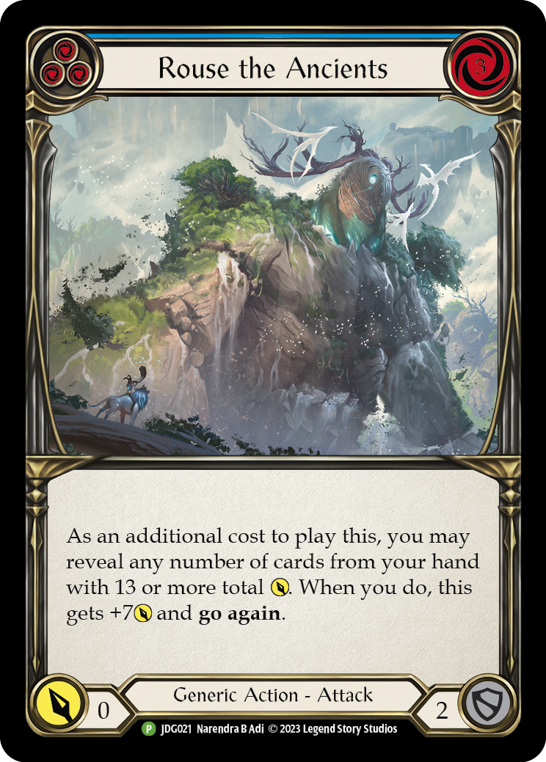
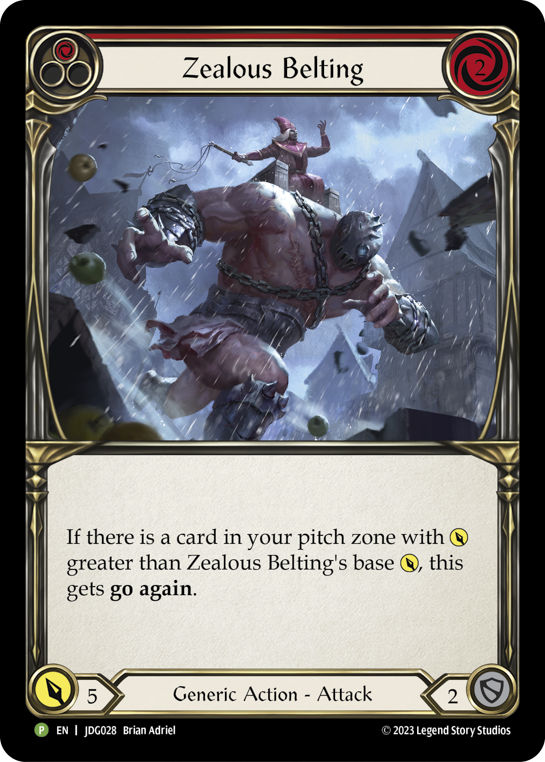
Ideally, we want to start the game with sticking potions to the battlefield, preventing damage, and gaining life through Sigil of Solace. If we can line it up, this is when we want to be attacking with Rouse the Ancients or Zealous Belting, potentially ending with a Flock or a potion - either one setting us up for success on future turns. This deck really wants to go second, but can benefit from being forced into going first: Tunic being one closer to popping off, or sticking a potion - especially Timesnap - can be a great turn one.
Ending the game is a bit more exciting. If we can start the turn with a Quicken token, then our turns can be extremely wide. I've had turns that go like this:
- Open with a red Flock from arsenal for 5, pitching blue from hand and revealing a blue Brandish or a potion.
- Pop the Quicken token we opened with.
- Using our new Quicken token, we pitch the potion we revealed to attack with the hammer: 6 with go again.
- With the final action point, pitch a blue to put 4 resources into the hammer.
This puts our damage output for the turn at 15-17, depending on the size of the Flock.
The more potions and resources that we can stack up for the endgame, the better. Timesnap Potions threaten 12-damage turns if you line them up with a simple double hammer swing. Energy Potions can do the same, if you have a Quicken token; suddenly, a hand of 2 blues threatens 12 damage.
The deck can certainly grind to a halt if it isn't given room to swing wide, but thankfully almost all of our cards block for 3 in a pinch. This is definitely more of a combo deck, one where we will do most of our damage on select turns after a little bit of setup. If you don't take the time to do the setup, or if you plumb aren't given the time to do your setup, then the game is going to go downhill fast. This makes it a decent choice for UPF as well, since you can play from a political position of low power, helping out other decks at the table while you innocuously get set up for the eventual endgame.
Don't Sleep on Guard Duty
Sledge Yoji is a pretty funny deck that does not translate well into Classic Constructed, but does do really well at Jank night. Nobody expects Guardian to spin up the whirlwind attacks, but really any of the Guardians can do it, and the more you practice the lines, the better you’ll get at piloting the deck. I recommend this list for having a good time and unwinding, and playing some fun games that still have powerful moves. It really is amazing how differently the game can be played even within the same cardpool – most of my Guardian decks don’t look like this! If you pilot it just right, and draw pretty well, the damage output is pretty crazy... and hardly anybody expects you to be playing the cards that you do.




